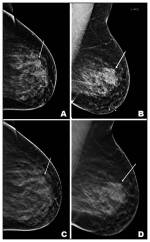Spread The News
(Credit: the American Journal of Medicine)
Researchers propose personalized approach to breast cancer screening
April 12, 2013
by Loren Bonner , DOTmed News Online Editor
New findings reported in the American Journal of Medicine this month seek to shed some light on the ongoing debate around screening mammography. Although mammography, considered the gold standard of breast cancer screening, has proved time and time again to reduce breast cancer mortality, study authors don't see it as the answer for every woman.
Instead, authors of the report argue for a more individualized approach to breast cancer screening. The paradigm shift includes new technologies to give patients a more personalized option based on certain factors like age, breast density, genetics and other risk factors.


"Mammography is not a perfect screening test," lead author Dr. Jennifer Drukteinis of the H. Lee Moffitt Cancer Center and Research Institute in Tampa, told DOTmed News. "There are sub-populations of women for whom mammography is less than ideal, such as women with dense breasts. There has also been significant controversy over the ideal age and interval to screen women by mammography. It is time to move beyond that argument and examine ways we can improve the breast cancer screening paradigm."
In response to some of the limitations of mammography, new technologies for breast cancer screening have been developed, including low-dose mammography, contrast-enhanced mammography, tomosynthesis, automated whole breast ultrasound, molecular imaging, and magnetic resonance imaging, all of which are discussed in the report.
"We chose to outline the major emerging technologies that are commercially available in breast cancer screening, as well as those not yet available that have shown promise in studies to improve the sensitivity and specificity of breast cancer screening," said Drukteinis.
Not only did the report relay a vision for the future, but it was also intended to educate clinicians about emerging technologies in breast cancer screening that patients may inquire about, according to Drukteinis.
Tomosynthesis, for example, a popular FDA approved technology that produces 3-D "slices" of an entire breast tissue volume, can eliminate the pitfalls of overlapping tissue, and has the potential to lower recall rates on screening mammography and reduce false negative examinations due to dense breast tissue. However, radiation exposure is a concern, as is decreased sensitivity for detection of microcalcifications, according to the report.
"The development of a personalized, individual patient-centered approach to breast cancer screening mirrors the evolution of similar strategies in other aspects of medicine," wrote Dr. Robert Stern, a radiologist affiliated with the University of Arizona College of Medicine, in an accompanying editorial. He cites the intricacies of each modality and one critical point that should be considered with such an approach: The need for a much closer working relationship between breast imagers and clinicians to make sure each woman undergoes breast cancer screening tailored to her.
Instead, authors of the report argue for a more individualized approach to breast cancer screening. The paradigm shift includes new technologies to give patients a more personalized option based on certain factors like age, breast density, genetics and other risk factors.
Story Continues Below Advertisement
"Mammography is not a perfect screening test," lead author Dr. Jennifer Drukteinis of the H. Lee Moffitt Cancer Center and Research Institute in Tampa, told DOTmed News. "There are sub-populations of women for whom mammography is less than ideal, such as women with dense breasts. There has also been significant controversy over the ideal age and interval to screen women by mammography. It is time to move beyond that argument and examine ways we can improve the breast cancer screening paradigm."
In response to some of the limitations of mammography, new technologies for breast cancer screening have been developed, including low-dose mammography, contrast-enhanced mammography, tomosynthesis, automated whole breast ultrasound, molecular imaging, and magnetic resonance imaging, all of which are discussed in the report.
"We chose to outline the major emerging technologies that are commercially available in breast cancer screening, as well as those not yet available that have shown promise in studies to improve the sensitivity and specificity of breast cancer screening," said Drukteinis.
Not only did the report relay a vision for the future, but it was also intended to educate clinicians about emerging technologies in breast cancer screening that patients may inquire about, according to Drukteinis.
Tomosynthesis, for example, a popular FDA approved technology that produces 3-D "slices" of an entire breast tissue volume, can eliminate the pitfalls of overlapping tissue, and has the potential to lower recall rates on screening mammography and reduce false negative examinations due to dense breast tissue. However, radiation exposure is a concern, as is decreased sensitivity for detection of microcalcifications, according to the report.
"The development of a personalized, individual patient-centered approach to breast cancer screening mirrors the evolution of similar strategies in other aspects of medicine," wrote Dr. Robert Stern, a radiologist affiliated with the University of Arizona College of Medicine, in an accompanying editorial. He cites the intricacies of each modality and one critical point that should be considered with such an approach: The need for a much closer working relationship between breast imagers and clinicians to make sure each woman undergoes breast cancer screening tailored to her.

 Write a Comment
Write a Comment


No comments:
Post a Comment